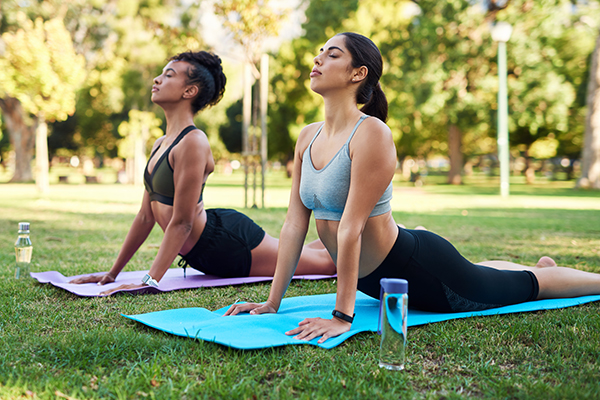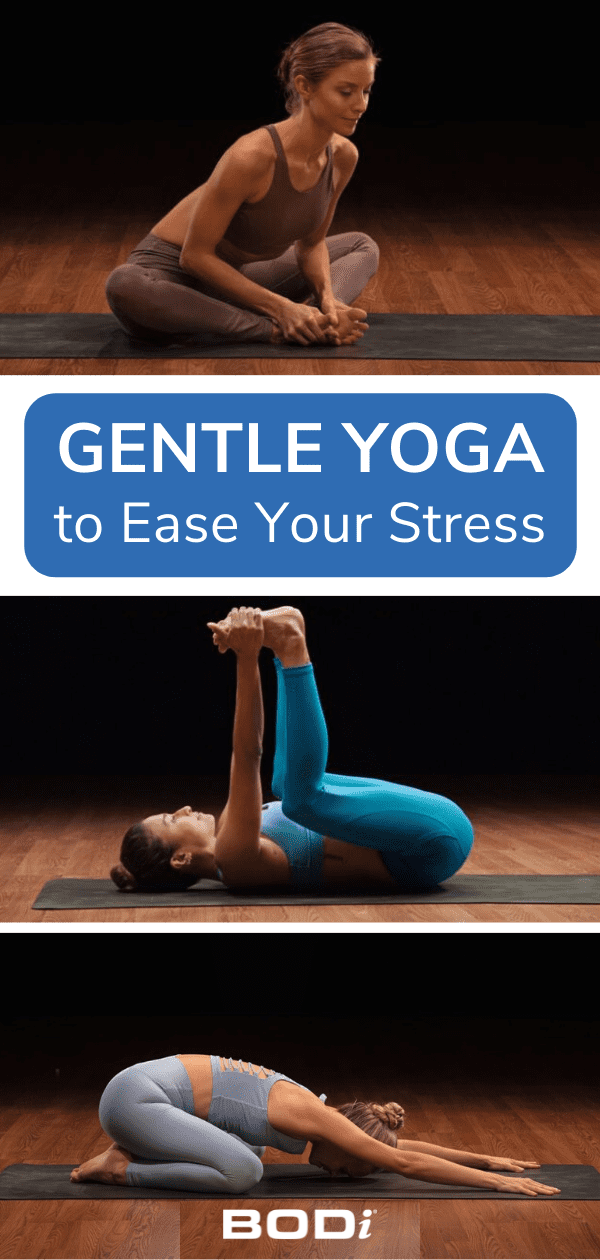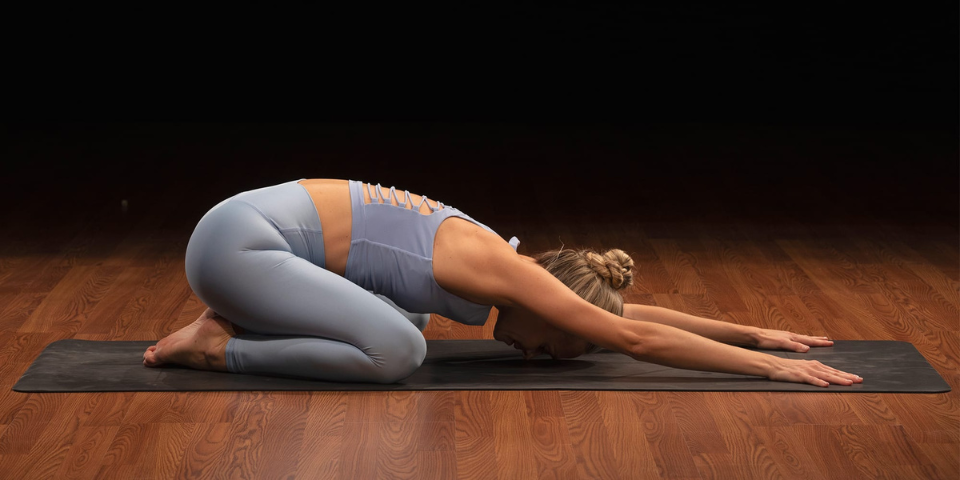If you think yoga has to do with hands stops and contort your body in Almost impossibleYou should know that there are several different forms Practice yoga. Soft yoga, for example, is appropriate for almost any person, beginners and veterans equally.
“Soft yoga offers a nutritional and compassionate approach to the body,” he says Sarah CumminsRyt 500, E-RYT 200, YACEP, Yoga Instructor and Certified Personal Coach. “It is often taught in a way that all people can easily participate.”
What is soft yoga?

Soft yoga is a slow and quiet practice in which you normally have poses for prolonged periods of time.
“Soft yoga can be taught in several ways, based on the style or lineage and experience of its instructor,” says Cummins. “Soft yoga can combine a slow flow with longer restorative positions that often include an emphasis on breathing and Meditation practices. “
While each class will vary, this is what you can expect in a soft yoga class according to Cummins:
- The signals on how to safely and adequately align your body.
- Tips for using accessories such as blocks, straps, blankets and bouths to help with alignment and relaxation.
- Less transitions of sitting to stand or kneel to bed for a softer and more relaxed experience.
- Many options and modifications to “meet you where you are and leave space for poses exploration,” she says.
Soft yoga types
Some yoga studies offer “slow flow” classes that are a softer form of Yoga Vinyasa. AND restorative yoga and Yin Yoga Both are considered “soft” yoga practices.
While both the restorative yoga and the Yin Yin yoga are soft in the body, there are some differences between the two styles:
Restorative Yoga: It incorporates approximately five or six postures that are intended to reduce speed and restore the body. Each pose remains for a couple of minutes, using several support accessories. The objective is the total comfort to release all the tension of its muscles.
Yin Yoga: It contains less poses for longer periods (three to five minutes), but “it is penetrating the deepest layers of Connective tissue To bring elasticity, mobilityand energy back to tight muscles. Most Yin poses are completely completed on the floor and most likely feel more challenging than restorative yoga, ”says Cummins.
Is gentle yoga for beginners?
Soft yoga is an excellent entry point for yoga for beginners. “Soft yoga allows students to move through slowly and consciously and practice yoga postures in a safe and effective way,” says Cummins.
But it is not only For newbies.
“It is a gratifying practice for young and old, the flexible and inflexible. It is also excellent for pregnant women and those who recover from injuries,” he adds.
Soft yoga sequence
Soft yoga can include a mixture of reclining, sitting and even standing or balanced postures. It is simple to make any yoga practice softer adding accessories, not go so “deep” in a pose or move more slowly.
Along with more intense flows, Yoga52 and Beachbody Yoga Studio In Bodi they offer relaxing practices that you can do at home to reduce from a long work day, they cool after training or prepare for bed.
If you are looking to create your own flow, here are some poses to try.
https://www.youtube.com/watch?v=dkpuvlwzfho
- Start standing with big fingers playing and a bit separate heels. Your arms should rest on the sides, the palms forward.
- Involve the thighs and lengthen the coxis down to create a long column.
- Lift your chest and draw the shoulder and down.
- Keep your ears on your shoulders and pelvis on your ankles.
- Breathe several deep breaths (consider holding for a minute).
https://www.youtube.com/watch?v=ir6p23O822s
- Start in the pose of the mountain with a separate hip distance (or a little wider). Place the yoga blocks in the mat in front of the feet. Breathe deep.
- Exhale, bend your knees slightly, Hinge in your hipsAnd rest your hands in the blocks.
- Look towards your legs and bend your knees as much as you want or need.
- Change your weight forward to align your hips on your heels.
- Stay here for at least three breaths.
- Breathe and get up again to stand. Press down with your feet and pull your low belly to support your lower back while developing.
https://www.youtube.com/watch?v=ohdmbnojnc4
- Start in your four -legged mat. Place your hands directly under your shoulders and knees under the hips. Gather your big fingers.
- Hold your hips towards your heels. Rest the belly between your thighs and touch your forehead to your mat.
- Extend your arms in front of you. Option to reach your arms behind you and taats of your heels.
- Stay for breaths/minutes.
4. Cat cow stretch (Bitilasana and MARJORASANA)
https://www.youtube.com/watch?v=fa4zms5m7xa
Inhale: Cow’s pose
- From the child’s pose, he returns to four legs. Keep your back, your long neck and look at the floor.
- While inhale, lift the coxis and chest towards the roof while dropping the belly into the mat.
- Take away your shoulders from your ears. Tighten the shoulder blades and lift your head in line with the torso.
- Exhale in cat’s pose.
Exhale: Cat Pose
- From cow pose, exhale, around the spine, put the coxis and curl the chin towards the chest.
- Inhale in cow pose.
- Repeat this flow for up to 10 breaths, or more if you wish.
- Come to a position sitting on your mat.
- Sit up with your legs extended in front of you. Flex your feet. Rest your hands to the sides on the ground.
- Affect your knees (option to place a blanket under the knees).
- Draw your abdominals and hing your hips to fold on your thighs. Walk your hands through your legs towards your feet. Avoid rounding your back or using your arms to get into the pose.
- Keep for five or more breaths. With each exhalation, try to relax in the posture to obtain a deeper stretch. Inhale again.
https://www.youtube.com/watch?v=vawm7Rh8yga
- Sit in your mat with the bones of the situation directly under you (avoid putting the coxis).
- Touch the soles of your feet together. Open the knees of torque as a book (option to slide two blocks under the knees if you have any knee tension).
- Slide the heels so close to his comfortable groin.
- Rest your thumbs on the balls of your feet. Wrap the rest of your fingers around the top of your feet fingers.
- Sit up. Keep your look forward and open chest.
- If you want to deepen the stretch, turn forward in your hips without rounding your back.
- Keep at least five breaths or a minute.
https://www.youtube.com/watch?v=0e0jwl8yyde
- Lie on your mat. Fold your knees and flatte your feet on the mat.
- Hug your knees on your chest. Take your knees to your chest and grab the outer edges of your feet.
- Throw your knees to the armpits.
- Comply the coxis from the mat (option to rock side by side).
- Stay for deep breaths.

- Lie on your mat.
- Let your arms rest a little away from your torso, with the palms up. Relax your shoulders away from the ears.
- Separate your legs until your heels reach the corners of your mat.
- Close your eyes and relax your whole body while slowing your breath and rests for at least five minutes.




